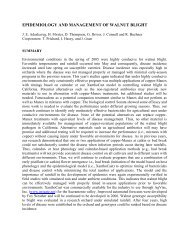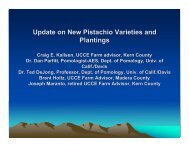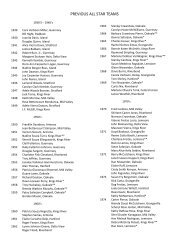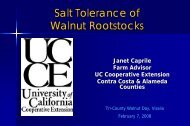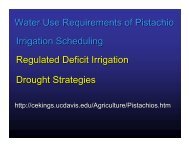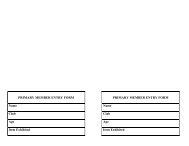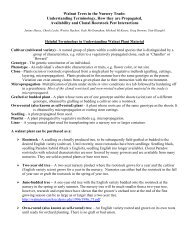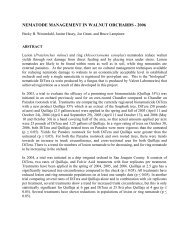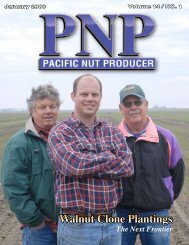using aerosol pheromone âpuffersâ - Walnut Research Reports
using aerosol pheromone âpuffersâ - Walnut Research Reports
using aerosol pheromone âpuffersâ - Walnut Research Reports
You also want an ePaper? Increase the reach of your titles
YUMPU automatically turns print PDFs into web optimized ePapers that Google loves.
act as an “early warning system”: they should not catch any moths in a <strong>pheromone</strong>-treated<br />
orchard. The Glenn County trial had 8 pairs of traps, one pair per every 25 acres. The San<br />
Joaquin trial used traps at a higher density, with a total of 39 pairs of traps. All traps were<br />
checked weekly and the lures changed as recommended by the manufacturer.<br />
In-season “canopy counts” of CM-damaged nuts were performed at least twice during the<br />
season, more if time allowed. At the Glenn site, 1000 nuts throughout the tree canopies were<br />
examined for CM damage in approximately every 25 acres. At the SJ site, 600 nuts were<br />
examined in each block. Independent consulting firms provide Pest Control Advisor service to<br />
both of the grower/cooperators involved. Data collected from all monitoring activities was<br />
shared with the grower/cooperator and Pest Control Advisor.<br />
Supplemental insecticides were applied as needed <strong>using</strong> the growers’ choice of materials, based<br />
on field monitoring and damage in individual blocks in 2005. Tables 1 and 2 list insecticide<br />
sprays to the Glenn and San Joaquin sites, and include all those which could affect codling moth,<br />
though some sprays target other insect pests such as walnut husk fly or navel orangeworm.<br />
Codling moth damage, total trap catches, and the number of sprays were compared to previous<br />
years to demonstrate reduction of broad spectrum insecticides and a move to softer insecticides<br />
to supplement PMD.<br />
Harvest samples were collected during commercial harvesting operations. Protocols for the<br />
collection of harvest samples varied slightly between the two sites due to the difference in plot<br />
layout. At the San Joaquin site, twenty 25-nut samples were collected from under trees after<br />
shaking in each test block. At the Glenn Co. site, ten 50-nut samples were collected in the<br />
general area of each of the 8 monitoring areas discussed above. All nuts were cracked and<br />
examined to assess damage from codling moth and navel orangeworm.<br />
Laminate Micro-Flakes<br />
In 2006, aerially applied Hercon laminate micro-flakes were used at three trial locations in the<br />
Sacramento Valley. The intentions of these trials were to test efficacy and a method of<br />
application and to document whether the flakes remained in the canopy or fell on the ground.<br />
The new bucket-type applicator and a reformulated sticker were used, both developed by Hercon<br />
Environmental<br />
The Hercon treatment blocks were between 14-20 acres, and each location included a “grower<br />
standard” (GS) where the grower used conventional pest control materials of his choosing. Each<br />
trial also included an untreated area of 1 to 2 acres. The Hercon flakes were applied at<br />
approximately 65 day intervals beginning when overwintering generation female moths began to<br />
be consistently caught in the indicator traps and the orchards had leaves mostly expanded. The<br />
Hercon treatment blocks at all three sites also received a supplemental Lorsban application to<br />
reduce risk to the grower, and because two of the locations had an unknown (to UC researchers)<br />
CM population.<br />
To obtain data measuring how well the Hercon flakes stuck on the leaves, both during the<br />
applications and for the 65 days afterwards, sheets of black plastic were laid on the ground and<br />
pinned down at the edges. The plastic sheets were 10 ft X 25 ft each and were placed in the tree<br />
row between two trees, five replicates at each location. The day of application and every week



